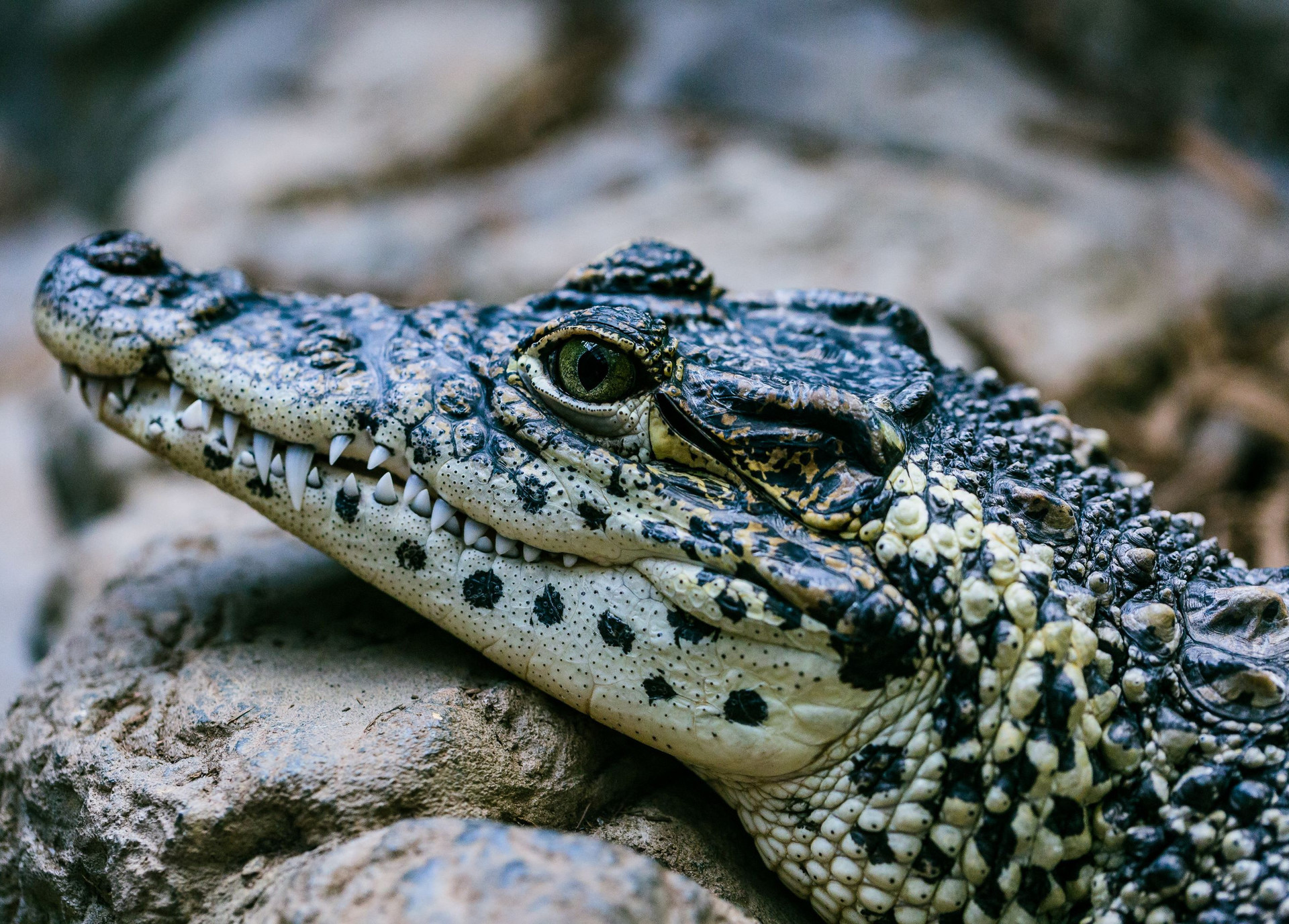
Exotic Leather
A life of horror: for some it even ends with being skinned alive.
Millions of wild animals are killed for their skin every year to produce exotic leather. Mainly reptiles such as alligators, caimans, reticulated pythons and water monitors are either bred on farms, or caught in the wild and brutally killed for luxury fashion items. Often their skins are turned into shoes, watch wrist bands or handbags
The exotic skin industry is organized globally and generates millions every year. In many areas government regulations are missing and there are serious animal welfare abuses. The lack of transparency and traceability across the industry also enables the unregulated exploitation of wild animals with legally and illegally sourced skins being frequently mixed together. This especially applies to the trade with python skins prior to export1

Crocodiles suffering on farms
Crocodiles, caimans and alligators are incredible at surviving. These fascinating creatures, who first appeared on earth around 200 million years ago, are facing a huge threat: being skinned for fashion.2
On crocodile and alligator farms for example in the USA, Columbia Australia and Southeast Asia , the general solitary animals are kept in large numbers in small enclosures with water basins and concrete platforms. In these overcrowded conditions the animals are unable to express any of the behaviors they would in the wild.
Crocodile farming and harvesting eggs from the wild are legal in many countries but these wild animals are entirely unsuited to farming and the result is cruel and distressing.
- In the overcrowded farm conditions the animals natural needs are ignored
- Crocodiles are wounded through fighting and develop deformities because they can’t express the behaviors they would in the wild.
- Wounds easily become infected in water that is polluted by overcrowding.
- Crocodiles have two-centimeter-thick skulls and slaughterers resort to barbaric methods including repeated blows with axes or baseball bats to smash through the animal’s skull.
- Crocodiles suffer extreme pain during the slaughter process, they often die a slow death and some even experience the unimaginable agony of being skinned alive.
- Farmed crocodiles are usually slaughtered at two to three years of age. In the wild they can live for 70 years.4

A large group of crocodiles crowded together on a small platform with more animals in the water
Caught and farmed snakes
Mainly pythons but also other snake species are bred in captivity or caught in the wild in Southeast Asia for fabricating leather-products. The removal of eggs or juvenile snakes from the wild to raise them in farms is also a method. Independent of their origin at the end they are brutally slaughtered for their skins. Often python skins from wild-caught animals are purposefully declared as captive-bred so that they can be exported.
- Wild snakes are captured with snares and sticks, put in bags and then transported to slaughterhouses. This process often leaves them traumatized, injured and distressed.
- On farms the animals are kept in tiny cages with no place to stretch or hide, no branches and without cooling and basking zones critical for regulating the animal’s body temperature.
- Snakes are killed by decapitation, drowning and bloating which involves the python’s mouth and anus being taped shut and the alimentary canal is filled with air using a compressor. This horrible slaughter methods cause great pain, fear, and stress.
What are we doing?
Change is underway. Growing demand for ethical fashion has driven a steady progression of major designers and fashion houses rejecting the use of exotic leather.
Brands such as Chanel, Victoria Beckham, Vivienne Westwood, Diane von Furstenberg and ASOS or retailers like Topshop, H&M and Selfridges have all banned the use and sale of exotic leather. They are helping to lead the way – the future of fashion must involve kindness to animals.
But, as long as there are animals suffering, we will continue our fight against this cruelty. We will expose the truth behind fashion and, through our Wear it Kind programme we will continue to mobilise a movement of people, brands and designers who are 100% committed to ensuring that no animal suffers for the sake of fashion.
We provide companies with the advice, training, and tools they need to make much-needed changes in their supply chains because each positive step they take improves the lives of animals.
What are we doing?
Change is underway. Growing demand for ethical fashion has driven a steady progression of major designers and fashion houses rejecting the use of exotic leather.
Brands such as Chanel, Victoria Beckham, Vivienne Westwood, Diane von Furstenberg and ASOS or retailers like Topshop, H&M and Selfridges have all banned the use and sale of exotic leather. They are helping to lead the way – the future of fashion must involve kindness to animals.
But, as long as there are animals suffering, we will continue our fight against this cruelty. We will expose the truth behind fashion and, through our Wear it Kind programme we will continue to mobilise a movement of people, brands and designers who are 100% committed to ensuring that no animal suffers for the sake of fashion.
We provide companies with the advice, training, and tools they need to make much-needed changes in their supply chains because each positive step they take improves the lives of animals.
How Can You Help
- Take the Wear it Kind pledge and commit to never buying exotic leather.
- Consumer pressure drives change, and your voice really can make a difference. Speak, or write, to the management of any store selling exotic leather.
- Use our Wear it Kind Shopping Guide to help you make great fashion choices.
Source
2. Smithsonian 2012, ‘The top 10 greatest survivors of evolution,’ https://www.smithsonianmag.com/science-nature/the-top-10-greatest-survivors-of-evolution-118143319/
3. O’Connell, S 2006, ‘Crocodile farms: is it cruel to keep these wild creatures captive?’, The Independent, https://www.independent.co.uk/climate-change/news/crocodile-farms-is-it-cruel-to-keep-these-wild-creatures-captive-418794.html
4. O’Connell, S 2006, ‘Crocodile farms: is it cruel to keep these wild creatures captive?’, The Independent, https://www.independent.co.uk/climate-change/news/crocodile-farms-is-it-cruel-to-keep-these-wild-creatures-captive-418794.html
